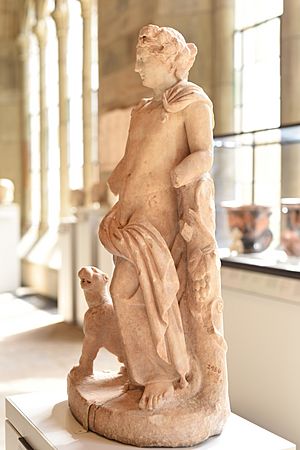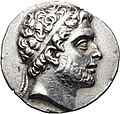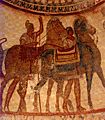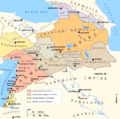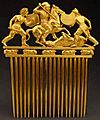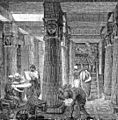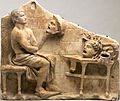Hellenistic period facts for kids
The Hellenistic period in Ancient Greece (323–146 BC) was after the death of Alexander the Great.
Greek culture, art and power expanded into the Near and Middle East. This period begins with the death of Alexander and ends with the Roman conquest of Greece.
At this time, Greek cultural influence and power was at its peak in Europe, North Africa and Western Asia, experiencing prosperity and progress in the arts, exploration, literature, theatre, architecture, music, mathematics, philosophy, and science.
It is often considered a period of transition, compared to the enlightenment of the Greek Classical era.
The Hellenistic period saw the rise of New Comedy, Alexandrian poetry, the Septuagint and the philosophies of Stoicism and Epicureanism. Greek science was advanced by the works of the mathematician Euclid and the polymath Archimedes.
The religious sphere expanded to include new gods such as the Greco-Egyptian Serapis, eastern deities such as Attis and Cybele and the Greek adoption of Buddhism.
Images for kids
-
The Nike of Samothrace is considered one of the greatest masterpieces of Hellenistic art.
-
Alexander fighting the Persian king Darius III. From the Alexander Mosaic, Naples National Archaeological Museum.
-
The distribution of satrapies in the Macedonian Empire after the Settlement in Babylon (323 BC).
-
The major Hellenistic kingdoms in 240 BC, including territories controlled by the Seleucid dynasty, the Ptolemaic dynasty, the Attalid dynasty, the Antigonid dynasty, and independent poleis of Hellenistic Greece
-
Gallo-Greek inscription: "Segomaros, son of Uillū, citizen (toutious) of Namausos, dedicated this sanctuary to Belesama"
-
Seleucus I Nicator founded the Seleucid Empire.
-
The Dying Gaul is a Roman marble copy of a Hellenistic work of the late 3rd century BC. Capitoline Museums, Rome.
-
Bust of Mithridates VI sporting a lion pelt headdress, a symbol of Herakles.
-
Al-Khazneh in Petra shows the Hellenistic influences on the Nabatean capital city
-
Model of Herod's Temple (renovation of the Second Temple) in the Israel Museum
-
Silver coin depicting Demetrius I of Bactria (reigned c. 200–180 BC), wearing an elephant scalp, symbol of his conquests of areas in the northwest of South Asia, where Afghanistan and Pakistan are today.
-
Greco-Scythian golden comb, from Solokha, early 4th century, Hermitage Museum
-
Statuette of Nike, Greek goddess of victory, from Vani, Georgia (country)
-
Perseus of Macedon surrenders to Paullus. Painting by Jean-François Pierre Peyron from 1802. Museum of Fine Arts, Budapest.
-
The Library of Alexandria in the Ptolemaic Kingdom, here shown in an artist's impression, was the largest and most significant library of the ancient world.
-
The Rosetta Stone, a trilingual Ptolemaic decree establishing the religious cult of Ptolemy V
-
Bull capital from Rampurva, one of the Pillars of Ashoka, Maurya Empire, 3rd century BC. Located in the Presidential Palace of Rashtrapati Bhavan, New Delhi. The subject matter is Indian (zebu), the global shape is influenced by Achaemenid styles, and the floral band incorporates Hellenistic designs (flame palmettes).
-
Bust of Zeus-Ammon, a deity with attributes from Greek and Egyptian gods.
-
Cybele, a Phrygian mother Goddess, enthroned, with lion, cornucopia and Mural crown.
-
Zeno of Citium founded Stoic philosophy.
-
The Antikythera mechanism was an ancient analog computer designed to calculate astronomical positions.
-
Ancient mechanical artillery: Catapults (standing), the chain drive of Polybolos (bottom center), Gastraphetes (on wall)
-
Head of an old woman, a good example of realism.
See also
 In Spanish: Período helenístico para niños
In Spanish: Período helenístico para niños


